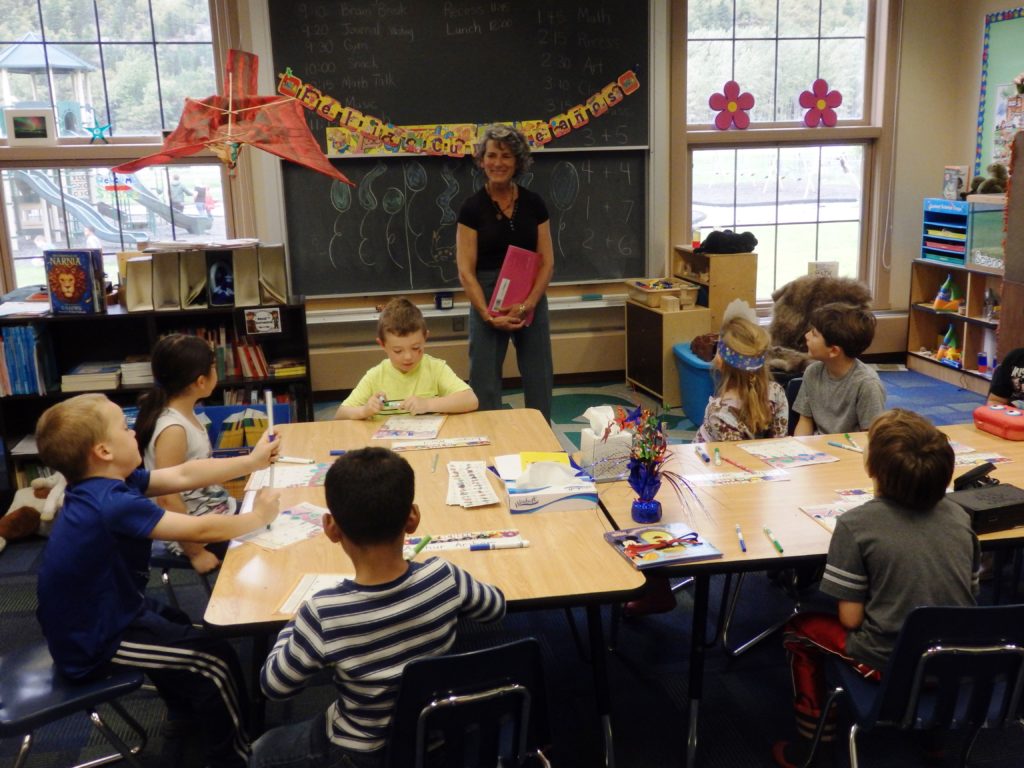For more than 20 years, Skagway School was small enough that all students were taught in multi-age classrooms.

But an increase in student enrollment prompted the school to transition to single-grade elementary classrooms this year.
It’s the second week of classes at Skagway School.
Teacher Courtney Ellingson has a math problem for her second-graders: If there are 13 cupcakes, and Kurt and Malcolm eat four of them, then how many cupcakes are left?
“So you kind of did some mental math there?” Ellingson asks one student about how she figured out the answer.
A few steps over, on the other side of a removable wall, first-graders are learning about math with their teacher, Denise Caposey.
“Did anyone get any different numbers? Did you get five and three also?” she prompts the students.
This is the first year since Ellingson and Caposey started teaching at Skagway School that they’ve been in separate classrooms. Before, they co-taught kindergarten through second grade.
“This is my 19th year teaching and I’ve never taught a single grade in all the years I’ve been at Skagway School,” Caposey said.
“For the first time in a generation, we have single-grade classrooms,” said Superintendent Josh Coughran.
Coughran proposed this big change to the school board last year.
Skagway had reached a major threshold – enrollment surpassed 100 students for the first time in about seven years. The jump in numbers meant a $280,000 increase in state funding, allowing the school to hire three new teachers and make the transition to single-grade classrooms.
“Enrollment is through the roof,” Coughran said. “Our high point of enrollment this year for K-12 was 124 students. We haven’t seen a number like that in 16 years.”
That number will likely drop a bit after seasonal residents leave around the end of September.
Coughran estimates that when the state does its official student count this fall, the school will have between 115 and 120 students.
Like first-grade teacher Caposey, fifth-grade teacher Mary Thole has taught at Skagway School for more than 15 years.
Until recently, she taught a combined fifth- and-sixth-grade group.
“For me the biggest change is you still have the same number of hours and minutes in the day,” Caposey said. “I had 50 minutes for math before and I taught two grades. So one lesson to one grade, another grade another lesson. I would go back and forth and I was literally jogging across the room.”
“Now I have one grade, one focus and I still have 50 minutes,” she said. “So I can go richer and deeper and just take more time.”
Thole says the curriculum is bound to evolve a lot this year, as teachers focus in on one grade after they’ve spent past years figuring out how to incorporate two sets of education standards and two different curriculums.
Superintendent Coughran says that’s the biggest benefit he’s heard from teachers: being able to focus on one grade and spend more time with each student.
“The only disadvantage I can think of is we’ve gotten so good at multi-age and multi-grade classrooms, and we’ve sharpened our skills so much in being able to do that, that perhaps you lose some of that,” he said.
Caposey says that’s the only hesitation she had about single-grade classrooms.
“I believe in multi-age groupings because of the fact that younger children work so well with the older students and older students are then able to be leaders of the younger ones and show what they know,” Caposey said.
The removable wall that separates the first and second grade makes it easy to incorporate group activities, like reading buddies.
“So we’re not completely letting go of our multi-age, it’s just that now we have single-grade teachers and that makes for more adult interaction.”
Thole has noticed another impact in her 10-student schoolroom:
“I feel a strength in the grade-level identity and the team and the connectedness that my fifth-graders have,” she said. “They can now define themselves that way, which they’ve never done before.”
Thole says the enrollment trend bodes well for Skagway’s year-round job prospects.
The 1,000-person town’s economy is heavily reliant on summer tourism and many people leave once the last cruise ship sails away.
The fact that more students are coming into the school could mean that Skagway’s economy is supporting more families staying year-round.
Emily Files is a reporter at KHNS in Haines.




